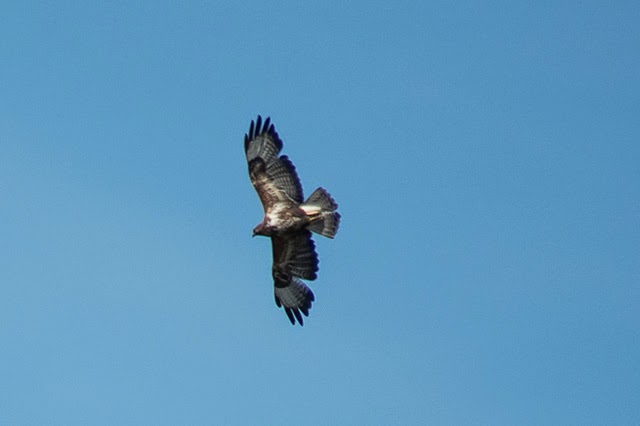Sunday 22nd. I drove out towards some local woods stopping to see two distant buzzards circling overhead. I jumped out of the car not expecting to see them over fields and fired off a couple of shots. When I looked at the back of the camera I realised they were honey buzzards, what luck. Apart from that and several common buzzards not much else to report.
Honey Buzzard
Common Buzzard for comparison
Honey Buzzard
Saturday 21st. A couple of hours to spare so I nipped down to the beach at Seasalter, the tide was just leaving the beach. On the high tide roost a few herring gulls plus 8 curlew and on the sea 9 common terns and 1 Sandwich tern. Inland, a group of 11 lapwings were flying west but not much else. I tempted myself to walk along the S.Swale LNR which as expected was dire, although the other week I did see a cuckoo there. The reedbed sported a few reed warblers and two reed buntings but no sign of beardies. Thank goodness the 36 cattle have been removed, no doubt they have trodden any nesting skylark and meadow pipit into the ground or deserted. Why do the KTNC persist in putting cattle on the thin strip of land at the beginning of the breeding season and leaving them for a couple of months to devastate the area. I walked through the sea of grass looking for a flower but it wasn't until I had walked half a mile to the white post when I found a buttercup that the cattle had somehow missed. I saw one small heath, two tortoiseshells, and a white (on the entrance track by the Sportsman PH), two emperor dragonflies and one blue-tailed damselfly in one of the ditches. Apart from that nothing! The reed bed is almost dried out after the farmer ripped out the dam to keep the water levels raised a couple of feet a couple of years ago. Its dying.
Just a sea of grass- no flowers, no insects, no birds.
The only patch of flowers managing to survive were salsify but even these were finally nipped of.
Friday 20th. A visit to East Blean woods didn't prove very rewarding although there were a few heath fritillaries about but not as many as in previous years. The 'rides' seemed very overgrown, not many open areas as in other years plus cow wheat appeared in short supply. I managed to see a few ringlets and large skippers plus a chiffchaff and green woodpecker betrayed their presence. Other than that fairly quiet!
Heath Fritillary
I tried a few shots at some of the hoverflies, this big one you see often hovering above your head with a pale saddle finally settled allowing a photo and also through boredom, a common housefly!
Leocozona lucorum
Housefly
Common Blue Damselfly
Large Skipper
Thursday 19th. I visited a local wet area near Reculver looking at dragonflies and insects. It was encouraging to see well over ten tortoiseshell butterflies and plenty of common blue damselflies, black-tailed skimmers plus a possible lesser emperor. Whilst getting down close to things I noticed a strange waspy looking insect that turned out to be a moth, a six banded clearwing.
Six Banded Clearwing
Common Darter
Upon leaving I walked down the track noticing a couple of ears sticking out of the grass, a hare. I lifted up the camera and waited. Seemingly, it didn't appear to realise what I was and started to come towards me but stopping occasionally to check me out again. Finally it came so close that I thought it best to come clean giving it time to dash off in the opposite direction.
Hare
On Monday 16th, I took a trip out of the county to see the short-toed eagle at Ashdown Forest. Luck was with me and I saw it straight away at the Gills Lap car park circling about half a mile away and too far for photos.

















2 comments:
Nice set of shots Mike, love the Honey Buzzard, a smart bird to see.
Like that first Hare image, very nice light.
Yet to see Honey Buzzard here, maybe this year i'll get lucky!
Post a Comment